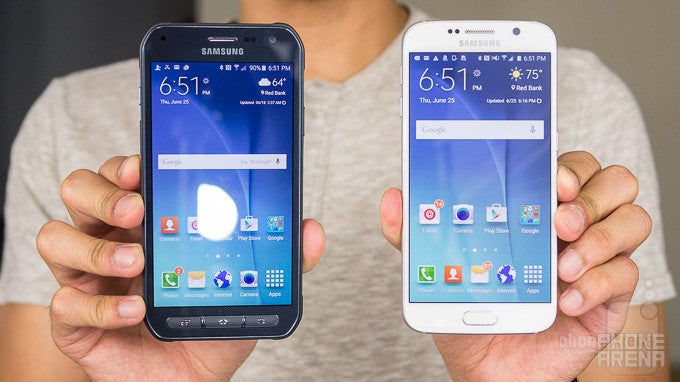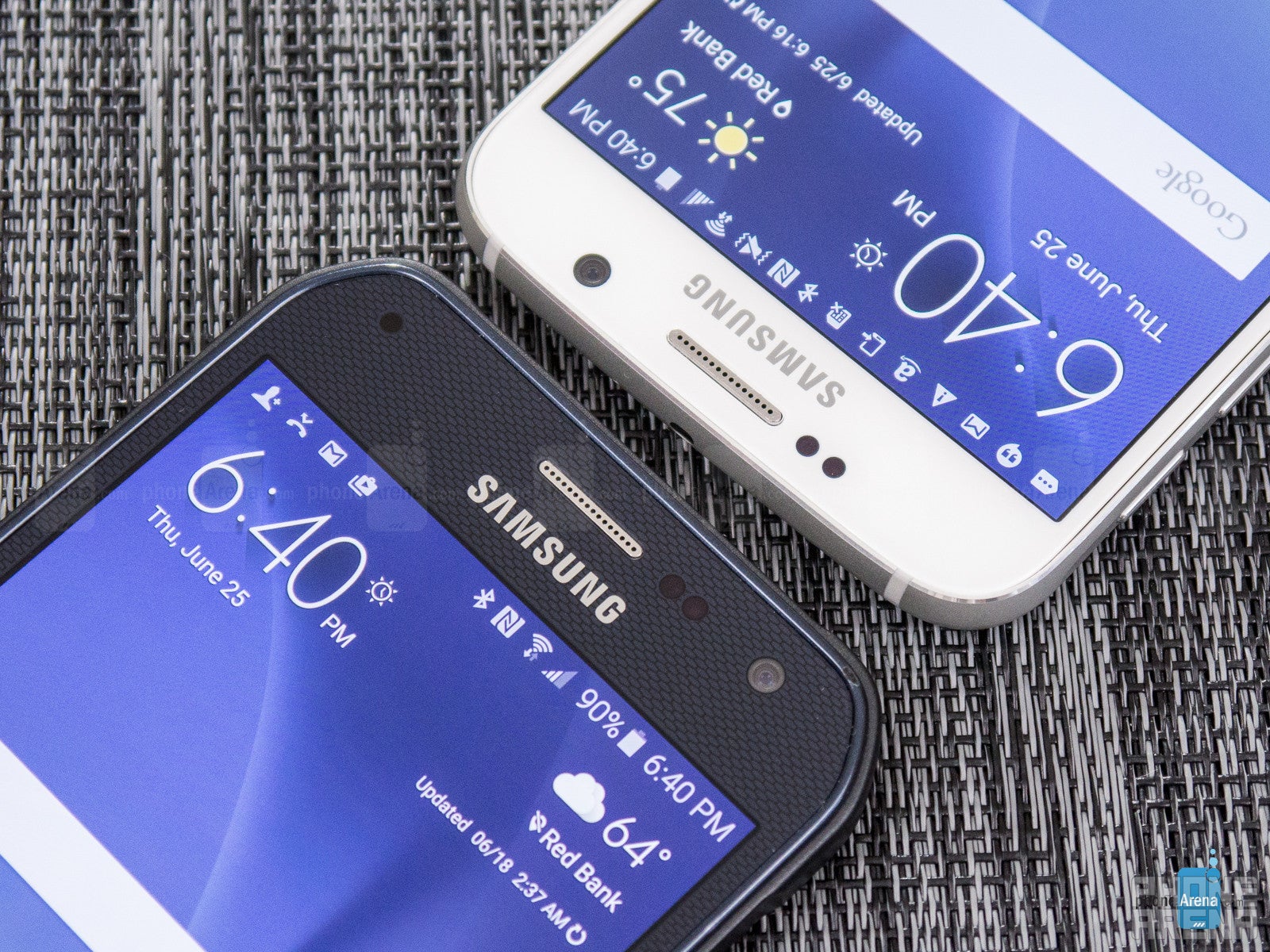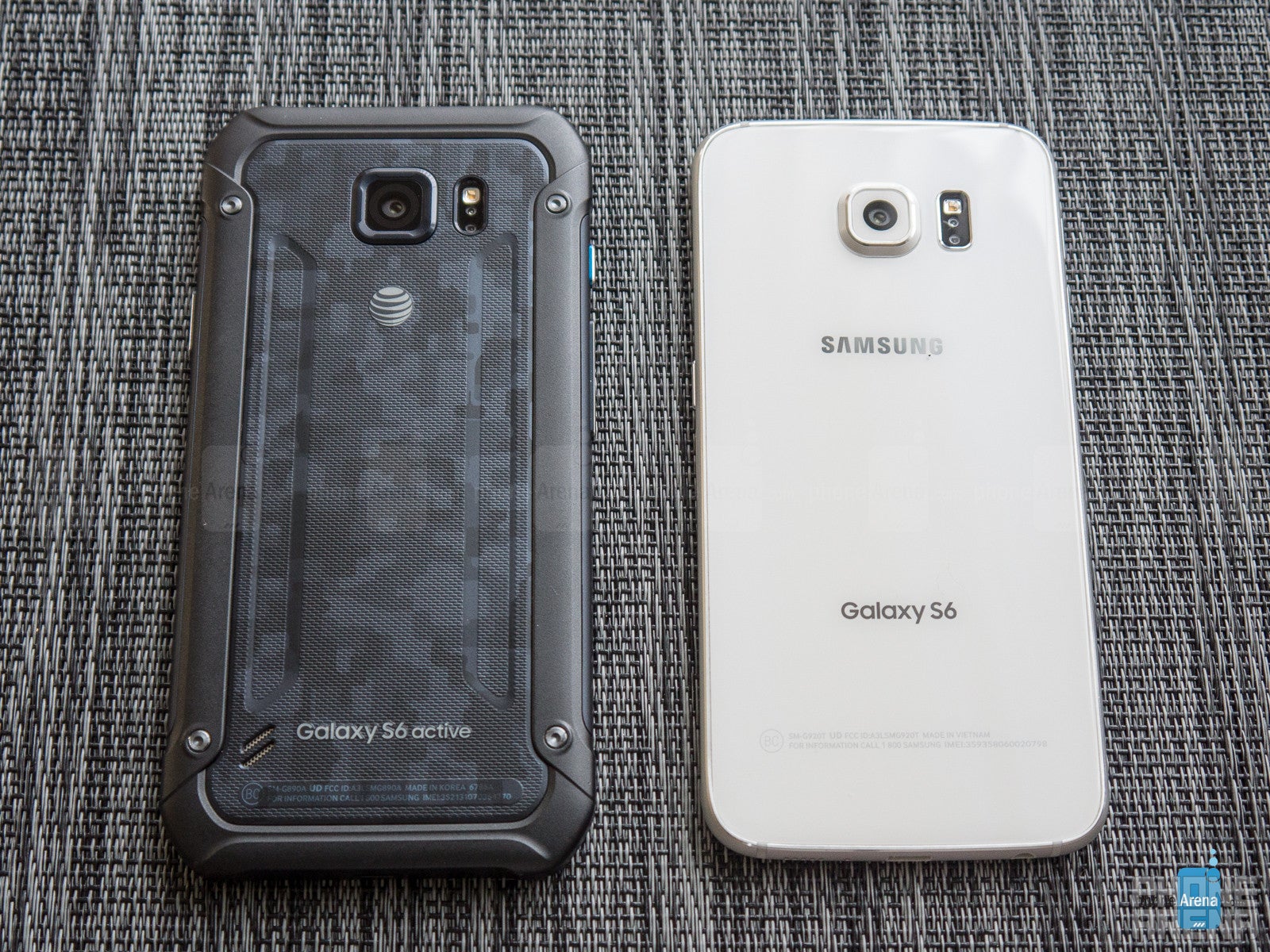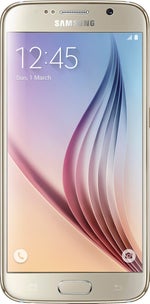Samsung Galaxy S6 Active vs Samsung Galaxy S6

Introduction
Excellence is a hallmark quality that Samsung thrives on with each and every product the company comes up with. Being one of the premier forces in the smartphone industry, Sammy went all out this year with the rollout of its flagship phone, the Samsung Galaxy S6, which to the surprise of many, went towards a completely new direction with the design of its phone. Shedding its prior reputation, the S6 proved to the critics that Samsung has what it takes to be fresh when it comes to phone designs.
While the premium design of the S6 is beloved, it sheds the water resistance quality of its predecessor – though, it’s something that’s prominently in full face with the recent Samsung Galaxy S6 Active. Although the specs sheet of both phones are similar, the visual designs are drastically different. That, of course, is what makes the decision to pick one even harder. Bearing that in mind, which one should you go with? The premium design of the Galaxy S6, or the impenetrable construction of the S6 Active?
Design
As we’ve clearly stated, Samsung’s new direction is profoundly evident with the Galaxy S6’s meticulous, premium design. Quite frankly, it simply boils to what appeals to you more. Indeed, the S6 exemplifies everything we want in a high-end phone, so that means a solid body that’s comprised out of metal and glass – made even better by how light bounces magically off its surfaces. One of the issues with having such a premium design, though, is that it’s more fragile and prone to serious damage when it’s dropped.
Not surprisingly, that’s not an issue with the Galaxy S6 Active, which might have an eyesore of a design depending on who you talk to, but it’s more function over form. Sporting an IP68 rating, the S6 Active is made to withstand everything that life can dish out – so it’s water resistant, dust proof, and shock resistant. Damage isn’t in the vocabulary of the S6 Active, seeing that its built-like-a-tank construction ensures it’s impenetrable.
Even though the two feature IR blasters, built-in wireless charging, and heart rate sensors, the S6 benefits from having higher security and support for mobile payments thanks to its fingerprint sensor – while the S6 Active features physical Android buttons and a higher capacity battery cell.
Display
Shattering the previous reputation that AMOLED technology had in the past, as in being overly saturated and subdued in bright conditions, Samsung yet again surprised us by perfecting the AMOLED screen – and these two phones prove that like no other! In fact, they’re flaunting the same screen, a 5.1-inch 1440 x 2560 Quad-HD Super AMOLED display.
Visually, our eyes are presented with screens rich in detail, potent in brightness, with extremely wide viewing angles, and colors that pop to impress. It’s one thing to base things visually with our eyes, but there are actually differences between the two – albeit, it’s not by much. For example, the S6 and S6 Active’s brightness outputs measure at around 570 nits, making them visible in even the brightest of condition. And it doesn’t end there!
Specifically, their color temperatures fall within a very close range to the perfect value of 6500 K. Previously, AMOLEDs have been known to produce unrealistic, over-saturated colors, but these two show that’s no longer the case. In fact, when they’re set to the ‘basic’ display mode, they accurately reproduce colors in the sRGB spectrum color chart. The only thing different here, from what we can see, is some sort of treatment applied to the S6 Active’s screen that repels water better.
Interface and Functionality
Considering that they’re in the same family, the experience between these two phones is nearly identical – so that means the latest version of Sammy’s streamlined TouchWiz UI running on top of Android 5.0.2 Lollipop. Therefore, the visuals and various software features are intact, offering us with useful functions without the redundancies that plagued previous iterations of the customized Android experience.
For the S6 Active, however, Samsung added one specific hub that caters to the outdoorsy type of individual; the Activity Zone. Basically, pressing the dedicated button launches the app, which offers quick glances and access to the weather, flashlight, music player, stopwatch, compass, S Health, and the barometer. Its usefulness, obviously, appeals mostly to a certain crowd, but downloading a collection of apps can offer a comparable experience over on the S6.
Besides that, the core experience between them are exactly the same. From Multi-Window to downloadable themes, the TouchWiz experience gets the job done for all sorts of users, it’s just a matter of actually liking the execution and visuals of TouchWiz.
Processor and Memory
Samsung raised eyebrows this year by going all in-house with the announcement of the Galaxy S6 line earlier this year. Bye-bye Qualcomm, hello Exynos one-hundred percent! In previous years, the US-variants were treated to chips from Qualcomm’s camp – while the international version stuck with Sammy’s silicon. The two here in this comparison are powered by a 64-bit octa-core Exynos 7420 processor, which breaks down to four Cortex-A57 cores running at 2.1GHz and another four Cortex-A53 cores clock in at 1.5GHz. In addition, it’s paired with a generous 3GB of RAM and the Mali-T760 GPU.
These are the fastest phones Sammy has ever produced, made more poignant by the results from its processing and graphics benchmark tests. In some cases, the S6 takes the checkered flag – while in others, it’s the S6 Active. All of this reveals to us that they’re just processing beasts, equipped to handle all sorts of operations whether they’re simple or complex. However, as we play around more with the S6 Active, we feel that there’s just a smidgen more snappiness with its response navigating through the interface. Although it’s not noticeable all the time, it could just be coincidence because we’ve been using the S6 for a longer period of time – compiling a collection of apps and taking up more of the storage in the process.
Speaking of storage, they’re offered at the minimum with 32GB of storage, despite our hopes of seeing a microSD card slot with the S6 Active prior to its official announcement. This means that users will need to be cautious about what things stay, and what things should go.
Internet and Connectivity
Running at full throttle, there’s no surprise that the Galaxy S6 & S6 Active are perfect web browsing machines. Once again, there is choice in what browser to use – either Samsung’s own Internet app or Google’s Chrome. Whichever one you decide to use, be sure that you won’t be disappointed by their offerings and executions. And just so you know, the quad-HD Super AMOLED displays on both devices picture the tiniest of things with an outstanding level of detail! Overall, the experience is accentuated by its effortless handling of complex sites, instantaneous responses with navigational controls, speedy page loads, and 2K-resolution details.
However, being the smartphone to feature a finger print sensor, the S6 has the added convenience of using it to automatically sign into certain sites. Rather than having to input your user name and password, all you got to do now is to use the finger print sensor to sign in.
On the mobile network connectivity side, Sammy doesn’t disappoint, as they are tooled out with many connectivity features. Being GSM-enabled smartphones, they have a high degree of compatibility with networks from around the world. Throw in expansive LTE band support while you're at it, in conjunction with category 6 downlink, and these bad boys will deliver download speeds of up to 300Mbps. Beyond that, they share all the standard-fare connectivity of today’s high-end phones, supporting things like GPS with Glonass, Bluetooth 4.1, dual-band 802.11 a/b/g/n/ac Wi-Fi, NFC, DLNA, MHL, and the ever-important microUSB 2.0 port.
Camera
When you have a good thing going, it’s only logical to follow through with a very similar product – hence that’s what we uncover here with their cameras. Boasting the same 16-megapixel Sony IMX240 sensor used in the Galaxy Note 4’s excellent camera, complemented with an even wider f/1.9 aperture lens, the sensor draws in more light to make it quite an effective thing to use for low light photography, among other usage scenarios. Additionally, the cameras offer optical image stabilization, BSI, LED flash, and infrared white balance to best adjust the shot for the given lighting conditions.
Of note is that the camera app is extremely fast to launch on both devices – you can call it up by double-pressing the home button at any time, which takes less than a second to get running. The reason why the camera app is so quick to start is because it never gets cleared from the system memory, so it's always running in the background. With 3GB of RAM in tow, it's safe to say this presents no problems.
Staying true to itself, Samsung retained TouchWiz's new design principles in the S6 & S6 Active's camera interface – it too has become refreshingly clean and minimalist. Most of it is dominated by the viewfinder, only to be flanked on the sides by its on-screen shutter key, mode change, and various settings/effects icons. Camera modes have been broken down to auto, selective focus, panorama, slow motion, fast motion, virtual shot, and pro. The latter gives full manual control – letting you adjust parameters for ISO, white balance, exposure compensation, and now focus as well. Best of all, you can save the settings for use later on. Aside from that, there are plenty of downloadable ones through the Galaxy App Store to further enhance the camera experience.
Image Quality
The Samsung Galaxy S6 & S6 Active's cameras make fantastic photos. The devices substitute for a practical point and shoot camera and come up with really impressive photos – especially taken in daylight, in automatic mode. Details are heavily emphasized, although not overly sharpened as one might be righteously afraid. Dynamic range decently – to the point that it casts a neutral exposure with most shots. Dynamic range is handled well, and the use of HDR mode adds a touch to shadows and highlights to reveal details that would otherwise be lost. Color reproduction is quite natural looking, so it’s neither too warm, nor too cold.
Outdoors and decent lighting is one thing, but smartphone cameras are unreliable for meeting the demands of low light photography. With the wider f/1.9 aperture lens, Samsung aimed to squash those concerns as well. And with optical image stabilization as part of the package, the GS6 & S6 edge are solid performers in this difficult department. Although there is a certain degree of diminished quality, details are still defined in night-time shots, and the white balance setting is adequate. The smartphones don’t exhibit too much noise either.
To the untrained eye, the shots produced under low light by the two appear very similar, but we do notice just a slightly cooler color production with the S6 Active’s shots. It’s not too heavy, but subtle enough to notice when the same image taken under low light are placed side-by-side to one another
Where macro shots (close-ups) are concerned, they are great at giving focus to the subject in the foreground, while softening the background in the process – such as the case with the images of the flowers. By using selective focus mode, the bokeh or out of focus effect is subsequently intensified. This leads to the ability to have the focus set to the foreground or background post shot, and frankly, the results are quite good!
We have good things to say to those favoring video capture as well, because neither the Samsung Galaxy S6 nor the S6 Active disappoint in their abilities to record. Not only is there a wide degree of shooting modes, such a UHD, QHD, 1080p at 60 FPS, 1080p at 30 FPS, and 720p at 120 FPS to name a few, but the results from each are very good. The UHD video mode, in particular, records such an ample amount of detail that the digital zoom offered by the camera proves effective enough. Other qualities include smooth auto-focus, minimal artifacting when panning, gradual exposure adjustment, and clear audio recording.
In 1080p recording scenarios, we still can’t complain. 1080p at 60 FPS gives video that “extra” level of motion, but details become rather soft for some reason. The 1080p recording at 30 FPS gives much sharper visuals.
Overall, it shows that these phones offer the utility needed in taking quick and simple shots – and in all sorts of lighting conditions. Throw in the fact that the top-notch qualities are backed by a deeply selective set of shooting modes and controls, they’re the perfect things for enthusiast to use day in, day out. You won’t be disappointed by either of them! Although, we can’t neglect to say that the S6 Active’s water resistant construction enables it to capture content under water as well.
Multimedia
Although the TouchWiz music player that comes as an alternative to Google Music Player doesn't look as dazzling as say, the new Sense 7.0 music player, the toned down approach definitely gives it that nice streamlined feel.
Of course, visuals alone aren't enough. The S6 Active achieves a higher output of 83 dB of power through the speaker on its back side, which hands down eclipses the 73.7 dB reach of the Galaxy S6. While volume output isn’t an issue here, what is, though, is that the S6’s speaker performance is thin and subdued sounding – while the S6 Active has an overly-sharpened tone that doesn’t make it the most pleasant thing to hear.
When it comes to multimedia editing and consumption, photo retouching tools are diverse through the Gallery app, even though there’s nothing exclusive or unique about the tools at our disposal. Watching videos, though? Both the GS6 & GS6 Active are seriously impressive at that. When the display is set to adaptive mode, it’ll automatically adjust the color saturation of videos to make them even juicier, while the Pop Up Play option still lets you have a video continue playing in its own window. Great stuff!
Call Quality

Battery

Our battery benchmark test is one thing, but our real world experience also sheds some light on the S6 Active’s impressive reach. Whereas the S6 generally lasts us a single day of normal usage, the S6 Active on the other hand, is usually only half-way through its battery life after a full day – giving us plenty of juice to continue using it for another consecutive day.
Even with the thicker body, the S6 Active still manages to retain the built-in wireless charging functionality of the S6. Meanwhile, if you prefer the good ‘ol way of charging via microUSB 2.0, their rapid charging ports allows them to be juiced back to 100% capacity in just a jiffy. Due to its higher capacity battery cell, the S6 Active requires 103 minutes to get back to one-hundred percent – while the S6 only needs 78 minutes.
Conclusion
Decisions, decisions! We all thought it was going to be an easy one this year choosing the best Android phone, but Sammy just wants to make it harder on all of us. That’s not a bad thing per se, especially when there’s variety and choice with its S6 line, but between the two here in this comparison, it comes down to design – that’s the single, greatest differentiator between them.It’s made more prominent when we look at their pricing, which surprisingly enough, are made available through AT&T for the 2-year contract price of $200. In terms of their outright pricing, the S6 Active sees a $10 premium over the standard S6. Who knows why that’s the case exactly, but it is. Nevertheless, pricing isn’t something that solidifies which one of them is the more logical and valuable choice.
Going back to what we stated initially, it’s going to come down to which of the two designs are regarded as the favorable one. While the S6 impresses us with its premium nature, the S6 Active goes in the opposite direction by offering an impenetrable design, which isn’t the most exciting or attractive design we’ve seen, but it serves its purpose. Whatever the decision, you won’t be disappointed by their performances.

Samsung Galaxy S6 Active
Pros
- Tougher construction
- Water resistant, shock resistant, & dust proof
- Longer battery life
- Stronger earpiece volume
Samsung Galaxy S6
Pros
- Beautifully designed phone
- Utilizes high-quality materials with its construction
- Slimmer profile
- Finger print sensor offers security & mobile payments
Follow us on Google News



















![A new Android bug is making it impossible to install new apps. Are you affected? [UPDATE]](https://m-cdn.phonearena.com/images/article/176703-wide-two_350/A-new-Android-bug-is-making-it-impossible-to-install-new-apps.-Are-you-affected-UPDATE.webp)

Things that are NOT allowed:
To help keep our community safe and free from spam, we apply temporary limits to newly created accounts: